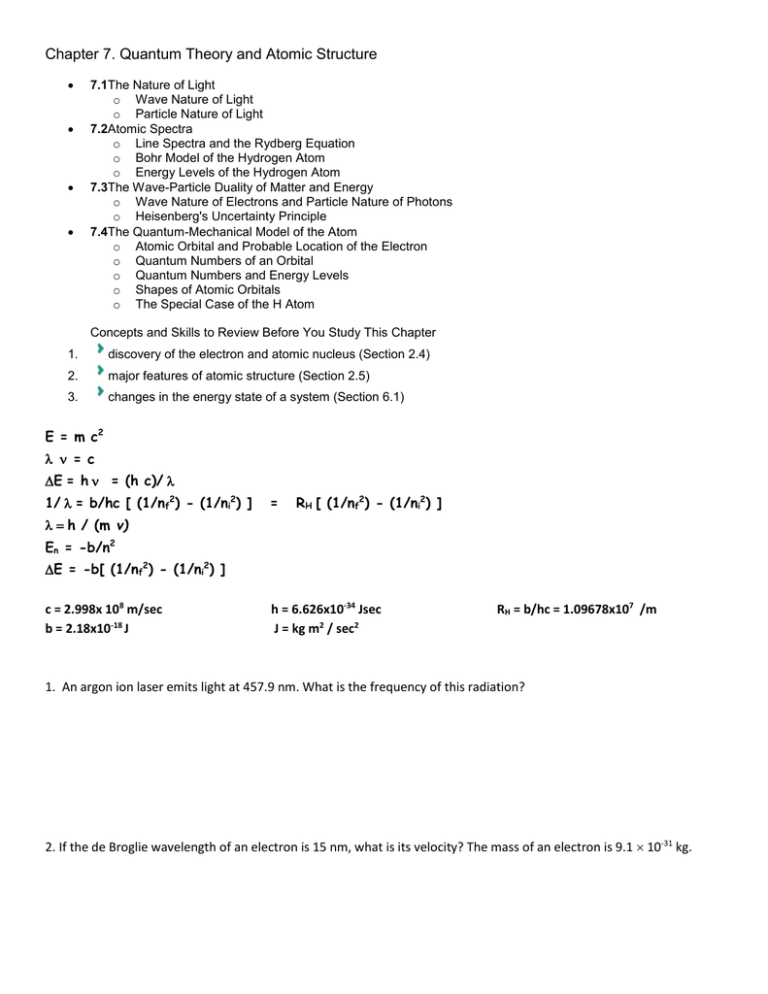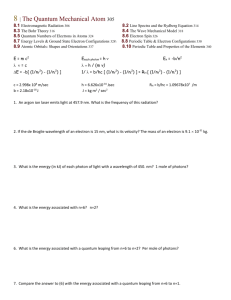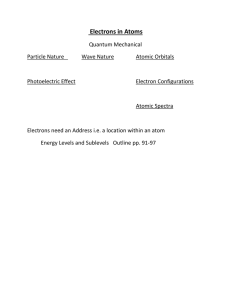Chapter 7. Quantum Theory and Atomic Structure
advertisement

Chapter 7. Quantum Theory and Atomic Structure 7.1The Nature of Light o Wave Nature of Light o Particle Nature of Light 7.2Atomic Spectra o Line Spectra and the Rydberg Equation o Bohr Model of the Hydrogen Atom o Energy Levels of the Hydrogen Atom 7.3The Wave-Particle Duality of Matter and Energy o Wave Nature of Electrons and Particle Nature of Photons o Heisenberg's Uncertainty Principle 7.4The Quantum-Mechanical Model of the Atom o Atomic Orbital and Probable Location of the Electron o Quantum Numbers of an Orbital o Quantum Numbers and Energy Levels o Shapes of Atomic Orbitals o The Special Case of the H Atom Concepts and Skills to Review Before You Study This Chapter 1. discovery of the electron and atomic nucleus (Section 2.4) 2. major features of atomic structure (Section 2.5) 3. changes in the energy state of a system (Section 6.1) E = m c2 = c E = h = (h c)/ 1/= b/hc [ (1/nf2) - (1/ni2) ] = RH [ (1/nf2) - (1/ni2) ] h / (m v) En = -b/n2 E = -b[ (1/nf2) - (1/ni2) ] c = 2.998x 108 m/sec b = 2.18x10-18 J h = 6.626x10-34 Jsec J = kg m2 / sec2 RH = b/hc = 1.09678x107 /m 1. An argon ion laser emits light at 457.9 nm. What is the frequency of this radiation? 2. If the de Broglie wavelength of an electron is 15 nm, what is its velocity? The mass of an electron is 9.1 10-31 kg. 3. What is the energy (in kJ) of each photon of light with a wavelength of 450. nm? 4. What is the energy associated with a quantum leaping from n=6 to n=2? 5. Compare the answer to (4) with the energy associated with a quantum leaping from n=6 to n=1. 6. What is the wavelength associated with a quantum leaping from n=6 to n=2? 7. Compare the answer to (6) with the wavelength associated with a quantum leaping from n=6 to n=1. 8. Heisenberg uncertainty principle states that we cannot know exactly the position and velocity of an electron both at the same instant. Explain what we studied under ‘position’ and under ‘velocity’. What were the assumptions when studying ‘position’? “velocity”? Quantum numbers : 1) n = principal quantum number. – shell - size, energy, how many subshell types.. 1, 2, 3, 4, 5, 6.. 2) l = angular momentum (secondary) quantum number - subshells(s, p, d, f, g, h…) -energy, shape, number of nodal planes… 0, 1, 2, 3, 4, 5……to (n-1). 3) ml = magnetic quantum number - orbitals - describes the spatial orientation of the orbital. (how many ‘boxes’ to draw) range from –l to +l 4) ms = spin quantum number - electrons +1/2 (up arrow) for the first one, -1/2 (down arrow)for the second one. n l ml ms Note








